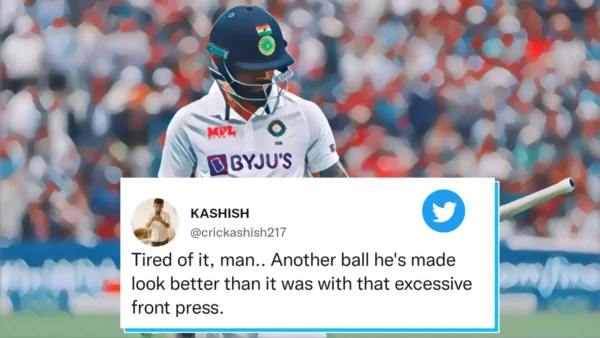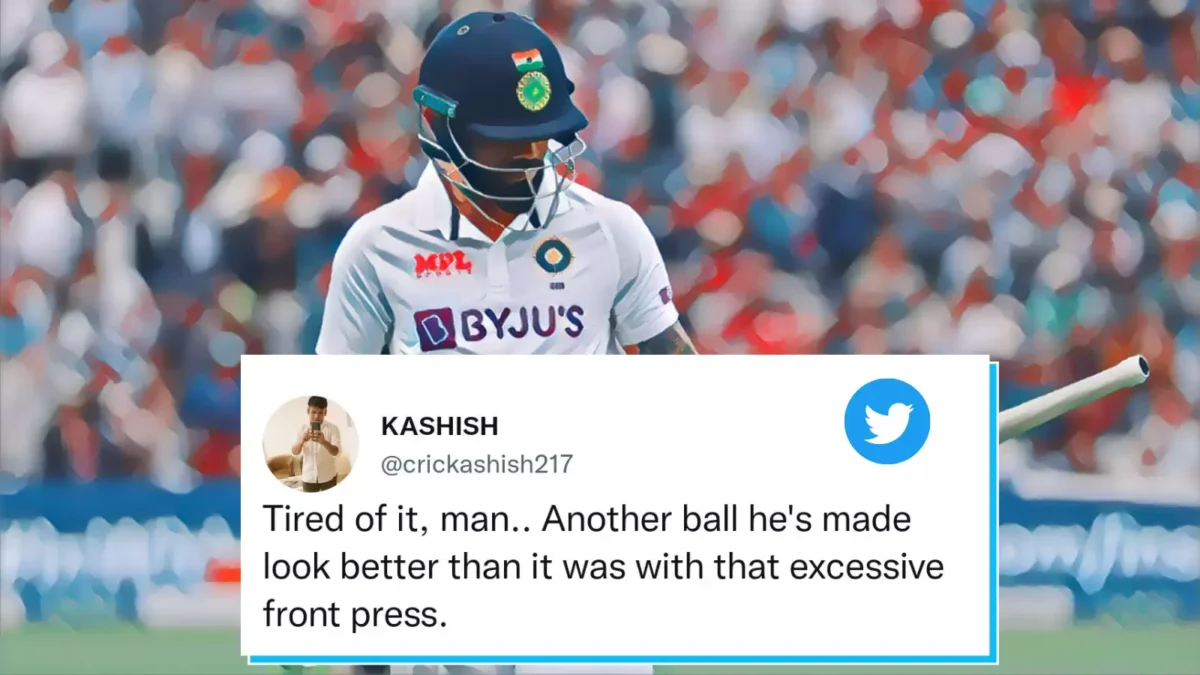
The Indian batting great has had a notorious obsession to counter everything from the frontfoot.

Having fought his way to 20 off 39 on Day 3 of the Edgbaston Test, Virat Kohli received a ball from Ben Stokes that reared off a length to hit the splice of his willow on its way to wicketkeeper Sam Billings before Joe Root took a one-handed rebound.
Kohli offered a smirk, presumably towards the Indian dressing room, feeling let down by a piece of misfortune since the ball had bounced off the turf touch awkwardly. The extra bounce did its thing and got the Indian batting great out when he was just beginning to set his eyes in for a long haul.
There is nothing new in disconcerting bounce getting the better of a player. It has happened many times to many batters and will continue to happen in our sport. Kohli is neither the first batter to be outdone in this fashion nor will he be the last.
Especially with the angle of the delivery from Stokes, who has this natural ability to make the right-handers play the one coming in from wider of the crease, only to be done by the late away swing on the ball and get edges flying to the slip cordon or the keeper. In that sense, Kohli was indeed foxed by a proper ball.
Tired of it, man.. Another ball he’s made look better than it was with that excessive front press. https://t.co/XcbP2OUKU4
— KASHISH (@crickashish217) July 3, 2022
But it wasn’t an unplayable one. Far from it.
For all the brilliance that Stokes imparted behind his delivery and the awkward bounce it unintentionally extracted off the deck, there is something to be said about Kohli’s role in the dismissal. For, again, he was out pressing forward to a ball that he could well have handled better off the backfoot.
As cricket fans, with a mind that has processed thousands of dismissals, we have developed a subconscious or conscious reaction towards each mode of wicket. Our instinctive reaction to occasions when a ball jumps off a length and leaves the batter in a spot has been one of sympathy towards the batter.
Regardless of our team inclination, we feel there is little that a batter could’ve done about it. And that could be true on some occasions – there is no way Jacques Kallis was getting out of the way of this one. But it isn’t like a batter can’t control the controllables always.
We seldom notice the error in judgement of the length and the nature of the batter’s response to a ball that rears off. Not all lengths make it impossible to handle the awkward bounce and survive at the crease.
When Cheteshwar Pujara got hit multiple times on his head and the gloves at the Gabba against Cummins and Hazlewood, we built in our conscience a tale of Pujara’s resilience and the pain-bearing ability for the larger good of the side.
What wasn’t paid enough attention to was the fact that Pujara was trying to keep the disconcerting bounce at bay while batting almost a foot outside the batting crease, leaving himself little time to adjust to the pace and bounce that the tall-statured Aussie bowlers were generating on the bounciest surface in the world.
That was Pujara following the Virat Kohli school of batting. It has caught up many Indian batters and left them with a diminished range behind square on the off-side. A bit on that later.
Cut to Edgbaston. Standing a foot outside the popping crease and then indulging in an excessive front-foot press, Kohli put all his weight and energy into a defensive prod without ever recognising or respecting the length of the ball.
The delivery from Stokes landed short of the good length area aligned towards the off-stump, which would traditionally command two safe responses: one where an average batter would shuffle back and across to defend the ball and the second where, if he has time up his sleeves, he might think of nudging or pulling it towards the on-side.
But Kohli tried to counter this with an ill-advised front-foot defensive prod, standing a foot outside the crease and then indulging in an excessive forward press. Think of it, this is a bonafide Test match batting great failing to react to the exact length of the delivery and trying to respond in a manner that is completely made up in his head.
What a ball from Stokes to get Virat Kohli. pic.twitter.com/ctGKibaEyL
— Johns. (@CricCrazyJohns) July 3, 2022
Kohli feels inclined to move at the ball because of his obsession with playing on the front foot. For him, the idea may have been to force bowlers to operate short at him and therefore cut down their swing. But as he has gone deeper into his career with this longstanding method, Kohli has been made to realise the limitations of it, for he often lacks enough time to play out the movement and, in this case, the bounce.
Against Stokes, he had committed to the front foot even before the ball landed on the turf. That it bounced awkwardly made it more difficult to handle. But Kohli made things worse for himself by pushing towards it rather than letting it come to him and reacting to it from the back foot.
The game of cricket has transformed so much, but an old adage stays true for batting: play forward when it’s full, go back when it is short. If a batter tries to press onto the front foot to a length meant to be played back, he is leaving himself vulnerable to a variety of dismissals and diminishing his range.
For unless the ball is really, really short and arriving at a slowing pace, the batter wouldn’t have the time to react to it and play square on both sides of the wicket. In Kohli’s case, he has managed to still be a strong on-side player. But with fast-bowlers smartly moving more to the off-stump than the middle and leg, Kohli has had shackles imposed on him, almost never playing a shot behind square on the off-side.
This has hurt him in what has been a bowling era in Test cricket, with home attacks more relentless than ever before. Kohli started off fine in the 2018-19 season, making four hundreds in 12 overseas Tests encompassing trips to South Africa, England, and Australia.
Since the start of 2020, however, he is averaging 28, with no hundreds to his name. The deeper he has gone into this phase, the tougher he has found to cover the loopholes in his technique.
You wonder then, why is he making his life all that more difficult with this front foot obsession?